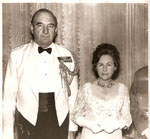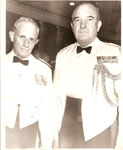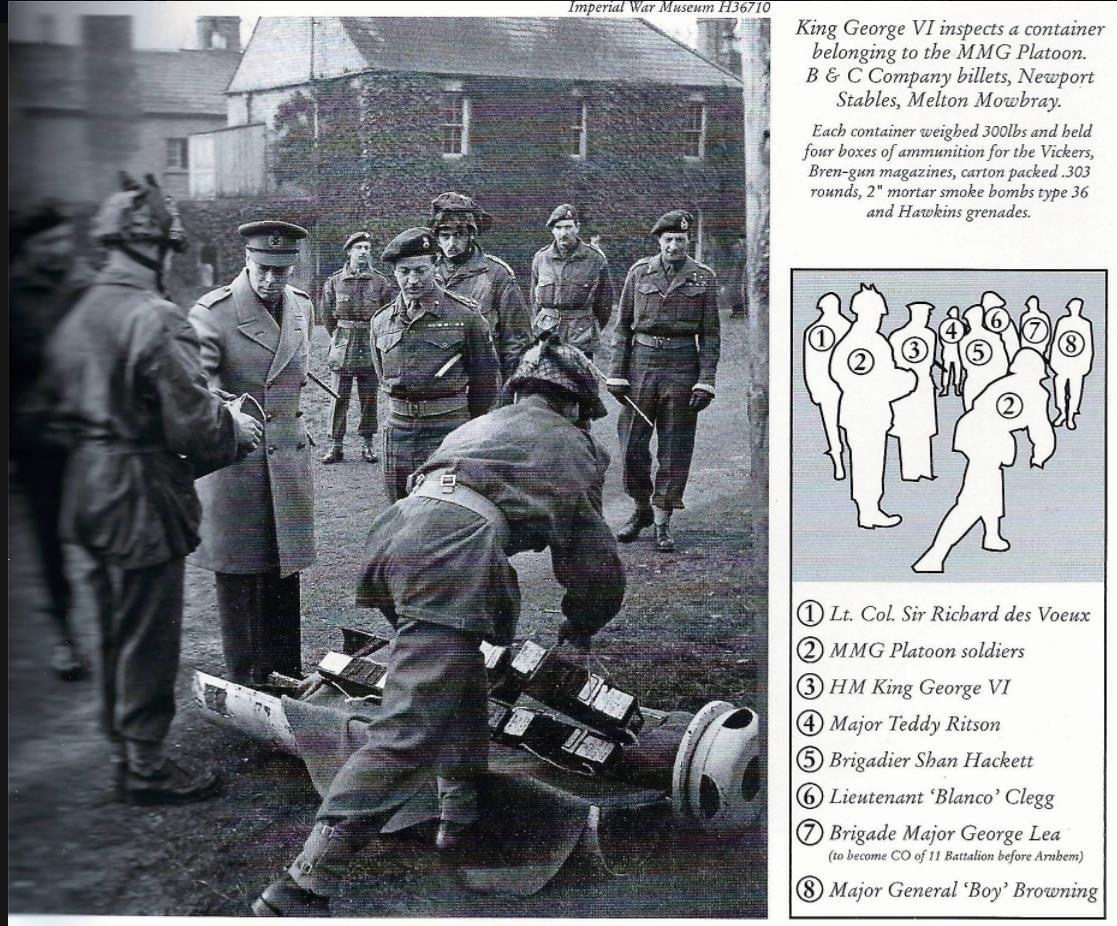Lieutenant General
Sir George Lea KCB DSO MBE
The last Colonel, XX The Lancashire Fusiliers

Lt Gen Sir George Harris Lea
and his wife Pamela |
Sir George Harris Lea, (1912-1990) was born on 28 December 1912 at Franche,
Kidderminster, Worcestershire, the eldest in the family of two sons and
three daughters of George Percy Lea, chairman of the family textile business,
and his wife, Jocelyn Clare, née Lea (his mother and father were
distant cousins). Educated at Charterhouse School and at the Royal Military
College, Sandhurst, he was commissioned into XX The Lancashire Fusiliers
in 1933. Lea was handsome, broad, and tall-well over 6 feet-a robust and
skilful games player, but a gentle and considerate man. He served in Britain,
China, and India with the Regiment before the Second World War.
In India in 1941, Lea was among
the first to join airborne forces, becoming in 1943 brigade major of 4th
Parachute Brigade during operations with the 1st Airborne Division in
Italy. Within this organization was 11th Battalion of the Parachute Regiment.
The 11th Battalion had proved
to be something of a problem after a series of administrative mishaps,
and also the previous commanding officer was not a firm enough man to
whip the Battalion into shape. So in early 1944 he was relieved of his
post and replaced by George Lea, then Brigade Major, who was promoted
to the rank of Lieutenant Colonel. In the coming months he made much progress
in bringing the 11th Battalion up to speed.
Lea and his men arrived in Arnhem on the second day of Operation Market
Garden. Upon landing, Lea was informed by Brigadier Hackett that the 11th
Battalion was detached from the Brigade and ordered to advance into Arnhem
to assist the 1st Parachute Brigade in their attempt to reach the Bridge.
However despite the need for urgency, the Battalion spent several hours
outside Divisional HQ until they received orders to move. When the order
came, they were skilfully led by some Dutch guides and with their help
they avoided a lot of German opposition and met with the 1st Parachute
Brigade during Monday night, having only suffered light casualties. Lea
arrived at the 1st Battalion HQ at about 02:30 on Tuesday 19th, and here
he conferred with Lt Col Dobie and Derek McCardie of the 2nd South Staffords.
It was decided their attack would commence at 04:00, with the 1st Battalion
and South Staffords leading the way, while Lea and his men followed on
behind in reserve.
The assault was viciously countered with heavy gun and mortar fire, and
continuous tank attacks. Both of the leading battalions were effectively
destroyed and George Lea was preparing to move his men in to assist, but
at 09:00 a vague order arrived on the radio from Major General Urquhart.
Having witnessed the fighting in the area, he decided that the 11th Battalion
should not move in to help as it would be an action that would only lead
to their unnecessary destruction. Lea ordered his men to hold and it was
a further two hours before fresh orders arrived for him. Urquhart now
charged the Battalion with the capture of some high ground in the area.
It was hoped that with this in their hands, the remainder of the 4th Parachute
Brigade would be able to make a successful attack in their direction.
Lt Col Lea gathered the remaining men of the South Staffords, now commanded
by Major Cain, and instructed them to capture some other high ground to
support their attack.
The 11th Battalion was engaged in heavy fighting by this time and it took
several hours for Lea to disengage his men from the battle, but they were
able to begin moving away by 14:30. Unfortunately the Germans realised
their intention and caught the whole battalion out in the open and cut
it apart with tanks and mortars. Only 150 men managed to get away from
the slaughter, however George Lea was not amongst them. He had been wounded
and was captured. He spent the rest of the war in a German prison camp.
After the war in 1946, Lieutenant Colonel Lea commanded the 15th (British)
Parachute Battalion until it was disbanded in December of that year.
In 1948 Lea married Pamela Elizabeth, daughter of Brigadier Guy Lovett-Tayleur.
His wife accompanied him wherever possible and contributed notably to
his accomplishments. They had a son and two daughters.
He continued his service with
airborne forces in India and at home, and in staff posts with the Royal
Marine commando brigade and NATO, as a lieutenant colonel, prior to taking
command of the Special Air Service regiment in 1955. Revived for the emergency
in Malaya, the unit lacked direction. Within ten days of his arrival,
a sergeant remarked: "the whole outfit came to life. He stretched
us-and himself-to the limit, but we could see it was leading to an operational
future."
On taking command, he immediately weeded out a number of unsuitable officers
and cast his eyes over the operational methods of 22 SAS. During the next
two years he developed the exacting standards and extraordinary skills
for which the Regiment became renowned and for which he was awarded the
Distinguished Service Order.
Fellow Lancashire Fusiliers who
served with 22 SAS, or its predecessor the Malayan Scouts, included Major
John Harrington, Captain Ian Cartright, Captain Billy Crawshaw, Captain
Ray England, Captain Rodney Carey, Staff Sergeant "Rocky" Mountain,
Sergeant 'Chopper' Essex, Corporal Geoff Brighouse, Corporal Geordie Plant
and Corporal Harry Goodman. A young Lieutenant Peter de la Cour de la
Billiere of the Durham Light Infantry, who was later to command, also
joined the Regiment during his tenure.
In the summer of 1955, a squadron
of SAS was raised in New Zealand and after rigorous selection and basic
training arrived in Malaya towards the end of the year, where they carried
out their parachute course. The total strength of the squadron was 140,
a third of whom were Maoris who found it easy to work with the aborigine
tribesmen. After a brief shakedown period they went on to make a valuable
contribution to the strength. Another squadron was added at the end of
1955, formed from volunteers from the Parachute Regiment where it was
known as the Parachute Regiment Squadron and commanded by Major Dudley
Coventry. These additions brought the strength of 22 SAS to 560 all ranks,
divided into five squadrons each with four troops of sixteen men, plus
headquarters personnel and attached specialists.
A normal pattern for a squadron was two months in the jungle, two wild
weeks of leave, two weeks retraining and then back to the jungle. There
were courses to be taken, new skills to be learned and training was continuous.
Lieutenant Colonel Lea instituted additional training for warfare worldwide
to secure the SAS a life after the emergency in Malaya ended.
By the end of 1955 the back of the Malayan terrorist campaign had been
broken and murder of civilians was down to five or six a month. The leadership
had fled to Thailand and the policy of rewarding defections had paid off.
Low flying aircraft equipped with loudspeakers made tempting offers of
money and food. During 1955, the Parachute Regiment Squadron operated
in the Ipoh area, hitting the headlines when they killed a woman terrorist,
'capturing' her six-month old baby, which they discovered afterwards and
then took care of the infant. 1956 and 1957 saw the SAS campaign wound
down. The Regiment had played a major role, and at the end of 1956 its
official score was 89 terrorists killed and nine captured. The momentum
was maintained with patrols that served to maintain the pressure on the
remaining terrorists.
In April 1957, the Parachute Regiment Squadron returned to England and
the New Zealanders also left, having accounted for fifteen terrorists
in their two-year tour. By then, 22 SAS was a highly trained regiment,
experienced and equipped with new weapons, skills and tactics and an adaptability
that would be proved time and time again in the future. For this, great
credit must go to the leadership and vision of George Lea.
Major Maurice Taylor, another Lancashire Fusilier then flying as an army
pilot recounts, "a nicer man you would never wish to meet and obviously
a great soldier. Great was the operative word too when you picked him
up in an Auster; about 250 lbs of him with a 60 lb Bergen usually with
another small giant with an even bigger Bergen and their weapons......talk
about scraping off the improvised airstrips we flew from back in those
days!"
As a consequence of his success
with 22 SAS, Lea was promoted directly to a brigade command in England
in 1957. He was then competing with peers in the more favoured armoured
warfare environment in Germany.
Appointment to command the 42nd
Lancashire Territorial Division and North-West District in Preston, Lancashire,
in 1962 appeared to limit his further employment. But he was selected
in 1963 to the politically sensitive command of the armed forces of Northern
Rhodesia and Nyasaland, colonies moving imminently to self-government.
His political tact and decisive containment of dissident groups were judged
exemplary. As this task concluded, he was chosen to succeed General Walter
Walker as Director of Borneo Operations early in 1965. His successive
aides-de-camp during these three command appointments were Captains John
Steeds, Lawrence Stacey and Christopher Berry of XX The Lancashire Fusiliers.
Responsibility for the civil
government of the former British Borneo territories had passed to Malaysia,
whose authority was disputed by neighbouring Indonesia and Chinese communists
in Sarawak. Lea was required to secure a mountainous border 1000 miles
in length amid dense jungle, and to pacify the communist faction. He served
three authorities: the British commander-in-chief in Singapore, the Malaysian
government in Kuala Lumpur, and, to an extent, the Sultan of Brunei.
Lea possessed only a proportion
of the powers necessary to ensure the co-operation of civil government,
the Malaysian police and armed services, and the Australian and New Zealand
sea, land, and air elements which reinforced his British forces from time
to time. The rest depended upon goodwill, which he won by his open manner,
humour, and modesty. Nothing ruffled him. Even when his wooden house caught
fire and he lost in minutes the greater part of his personal possessions,
he continued as if it were a matter of the least importance.
Making adroit use of air and
sea resources, Lea developed the policy of pre-emptive cross-border strikes
by his troops, while containing the Chinese communists with police backed
by military units. The success of these methods contributed to the change
of political leadership in Jakarta and the emergence of an accord between
Indonesia and Malaysia in 1966.
Promoted to lieutenant general,
he was posted in 1967 to Washington, DC, as head of the British Services
Joint Mission, the link between the British and American Joint Chiefs
of Staff. Maintaining the close alliance in a period of British economic
difficulty and defence retrenchment was not easy. But the Americans opened
their offices and confidences to him more fully than protocol demanded,
because they liked and respected him, as the chairman of the American
Joint Chiefs observed on his retirement in 1970. He had evoked similar
responses throughout the greater part of his professional life
Colonel of XX The Lancashire
Fusiliers from 1965 to 1968, George Lea was deputy colonel and then colonel
(1974-7) of the Royal Regiment of Fusiliers. He was appointed MBE (1950),
CB (1964), KCB (1967), and to the DSO (1957). For his services in Borneo,
he was made Dato Seri Setia, Order of Paduka Stia Negara, Brunei (1965).
He retired to live in Jersey and died at home in St Brelade, Jersey, on
27 December 1990.

Gen Darling and Gen Lea
sent in by
Mike Murray

|
